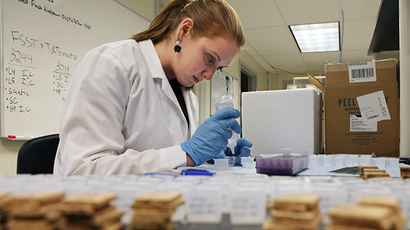Scientists cut HIV out of human genome

US scientists have physically cut the HIV virus out of infected cells by using enzymes. The method could, in theory, lead to a permanent cure for AIDS, though researchers warn there is still a long way to go.
Scientists from Temple University School of Medicine in Philadelphia have pioneered a technique which uses a targeting strand of RNA (called guide RNA, or gRNA) that locates the virus. A “DNA snipping” enzyme (called a nuclease) then removes it from the infected cell. The cell, now free of the HIV virus, then repairs itself.
Cells armed with the nuclease-RNA combination proved impervious to HIV infection, the research states.
“This is an important step on the path toward a permanent cure for AIDS. It’s an exciting discovery, but it’s not yet ready to go into the clinic. It’s a proof of concept that we’re moving in the right direction,” said Dr. Khalili, director of the Comprehensive NeuroAIDS Center at Temple and lead author of the study.
The editing process was successful in several cell types that can harbor HIV-1, including microglia and macrophages, as well as T-lymphocytes. "T-cells and monocytic cells are the main cell types infected by HIV-1, so they are the most important targets for this technology," Khalili said.
The research was published by the Proceedings of the National Academy of Sciences on Monday.
The HIV virus operates by permanently inserting its genome into a patient’s DNA, forcing them into a lifelong drugs regimen of antiretroviral therapy (HAART) to control the disease.
But, although the HAART treatment allows people to live a relatively normal life, there are growing problems of HIV drug resistance and the virus becomes active again if treatment is ever stopped.

Scientists have been struggling to find a cure for HIV for more than three decades, but the virus’ ability to “replicate unrelentingly despite everything the immune system can throw at it,” have made a cure an elusive goal, according to virologist Ron Desrosiers.
“Since HIV-1 is never cleared by the immune system, removal of the virus is required in order to cure the disease,” said Khalili.
But serious problems remain with the new technique. Scientists have still not found a way to deliver the DNA snipping enzymes to every cell, and there are concerns that the treatment could lead to unexpected side effects like cell mutations.
There is also a worry that the genetic diversity of the HIV virus – it is prone to mutations – may mean that treatment has to be tailored towards each strand of the virus.
So far, researchers have only targeted the virus in laboratory test tubes. But Dr. Khalili is optimistic that his technique is the best hope for a cure.
“We are working on a number of strategies so we can take the construct into preclinical studies. We want to eradicate every single copy of HIV-1 from the patient. That will cure AIDS. I think this technology is the way we can do it,” he said.
There are around 35 million people worldwide infected with HIV; 1.6 million died from AIDS related illnesses in 2012 – most of them in the third world, where treatment is not as advanced or available, according to the World Health Organization.














